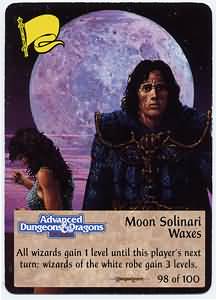
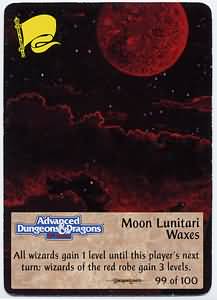
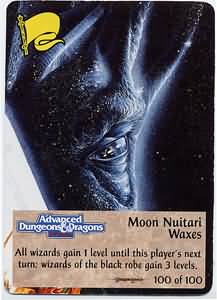
<img>
<l: d38>
|
|
|
|
|
|
|
|
|
|
|
|
|
|
|
|
|
|
|
|
|
|
|
|
|
|
|
|
|
|
Of all the orders of the
world of Krynn,
none are as old, as feared,
or as respected as <morale/reaction modifier?>
the Orders of High Sorcery.
They came into
being almost at the beginning
of the world;
their tale is that of the
three Gods of Magic.
The gods of magic, Solinari,
Lunitari, and Nuitari, <c?>
walked the face of creation
before the
stars settled in their places.
Though they had a
common love of magic, each
had aspects that
differed greatly from those
of the others. Each
also chose a different path
in the universe.
They saw the other gods wheeling
through
the heavens and aligning
themselves against
one another according to
their goals and philosophies.
The All-Saints War was coming,
as
their vision and foresight
had warned. The
three gods feared that they
too must choose.
Bound by the common bond
of magic, these
three looked about the face
of Krynn and
loved it greatly.
Thus they did not join their
fellow gods in
the heavens, but stayed
close to the world.
They revolved about it,
granting their powers
to those who would follow
their ways. Each
god was granted a time to
walk the face of
Krynn and seek out a follower.
Each found an
apprentice and to each did
they give the keys
to the Lost Citadel--a fabulous
place of wizardry
that stood beyond the circles
of the universe
itself. Here the gods taught
them the
Foundations of Wizardry.
1. All wizards are brothers
in their order.
All orders are brothers
in the power.
2. The places of High Wizardry
are held in
common among all orders
and no sorcery is to
be used there in anger against
fellow wizards.
3. The world beyond the
walls of the towers
may bring brother against
brother and order
against order, but such
is the way of the universe.
The Orders of Sorcery began
as loosely organized
groups of wizards. It was
not until much
later that the orders became
formalized and
structured. During the Age
of Dreams at the
onset of the First Dragonwar,
the masters of
each of the orders came
together at the Lost
Citadel and proclaimed the
unity of the
orders.
The Lost Citadel was a wondrous
place from
whence the master wizards
ruled their orders
in peace and harmony, far
removed from the
world of Krynn. Both palace
and fortress, it
provided a place where the
powers of magic
could be tempered by the
wisdom of the Conclave of Wizards (see page 29).
It is important for any
magic-user in Krynn
to remember that a wizard's
only loyalty is to
magic. This is the primary
reason that magic
has remained in the world,
despite many
efforts to eliminate it.
A wizard
of the Black Robes and a wizard of
the White fighting on opposing
sides of a war
(such as the War of the
Lance) would not hesitate
to destroy each other. When
these wizards
meet on neutral ground (such
as a Tower of
High Sorcery), they are
likely to enter into an
eager discussion of magic.
If attacked by an
outside force seen as a
threat to their magic (a
renegade wizard, for example),
both would
join together to fight in
defense of the magic.
A wealth
of information on wizards, magical lore,
The
Towers, and the Tower guardians
exists
in the DRAGONLANCE novels.
Those
interested in acquiring more detailed
info
than is provided here should
draw
from those works.
Q: Can a PC on Krynn
opt to become
an illusionist? Can a Wizard
of High
Sorcery cast both illusionist
and
magic-user spells?
A: All illusionists
on Krynn are renegades
(DLA, pages 13 and 36).
A Wizard of High
Sorcery can cast spells
from any sphere of
magic allowed to his order
(DLA, pages 35-
36 and 126-127), illusions
included.
(143.12)



Since
the creation of the world, the three
moons
of magic have circled the globe of
Krynn,
bringing with them the waxing and
the
waning of their followers' magical powers.
Each
of the three Orders of High Sorcery
receives
its powers from one of the moons of
magic.
Wizards
of the White Robes get their
powers
from Solinari, Black Robe wizards get
their
power from Nuitari, and neutral Wizards
get
theirs from the red moon, Lunitari. It
is
by the position and aspect of its moon that
each
order gains its enhanced powers. The
aspect
of Nuitari has no effect on the powers
of
the White Robed wizards, for example.
Only
the moon Solinari has an effect on the
wizards
of the White Robes. The precise
effects
of the positions of the moons on the
magic
of Krynn is shown by the following
tables.
Each phase of a moon has an effect on
the
magic of that class of wizards.
Moon
Phase Effects Table *
| Moon Phase | Saving Throw | Additional Spells <+> | Effective Level |
| Low Sanction | -1 | 0 | -1 |
| Waning | Normal | 0 | Even |
| Waxing | Normal | +1 | Even |
| High Sanction | +1 | +2 | +1 ** |
* A wizard of 1st through 3d level is unaffected
by
phases of the moons because of the
low
power levels involved in his spells. It is for
this
reason that the tests for wizards occur at
3d
level or above as this is the point at which
wizards
are considered to "come of age."
**
Only a wizard of 6th level or higher who
also
has an INT of 15 or above gains
this
benefit from the moons.
+ The
additional spells can be of any level
the
wizard can cast.
If two or more of the moons are aligned,
there
are bonuses to the moon phase effects
given
earlier. (Moons are aligned if the boxes
they
occupy on the Moon Tracking chart [page
28]
are in a straight line from the center of the
chart.
For example. Lunitari on day 3 of its
orbital
period is aligned with Nuitari on days
6
and 7 of its period and with Solinari on days
5
and 6 of its period.)
Moon Alignment Effects Table *
| Alignment | Saving Throw | Additional Spells | Effective Level |
| Sol. with Lun. | +1 | +1 | +1 |
| Nuit. with Lun. | +1 | +1 | +1 |
| Sol. with Nuit. | +1 | 0 | Normal |
| All Three Moons | +2 | +2 | +1 |
* Note
that all plusses on this table are
cumulative
with modifiers from other effects.
If
all the moons were to align at the time of
High
Sanction, then all wizards would have a
+3
saving throw, +4 additional spells and
+
2 effective levels to their spell casting. This
is
known as the Night of the Eye since the
moons
move through the sky with a terrible
aspect
and cause magic to be at its peak.
The
initial location of the moons is determined
by
rolling 1d8 for each moon and placing
it
in the indicated box along its orbit.
If
you are playing a DRAGONLANCE campaign
game,
then these are the starting locations
for
the moons in your campaign.
Hereafter,
advance the moons one box per
game
day to keep track of their positions during
the
campaign. This allows your players to
plan
for regular changes in the lunar cycles.
![]()
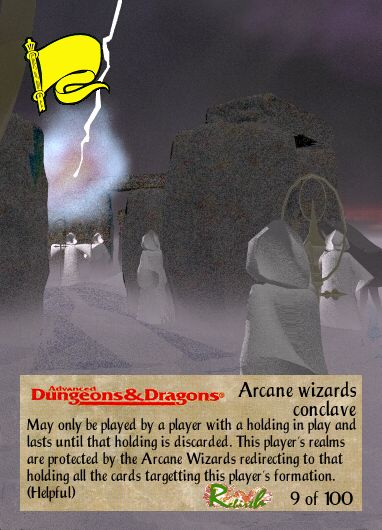
The Conclave of Wizards is
convened on set
dates and times as dictated
by the moons. The
Conclave meets regularly
once each Foutweek
on the first day of High
Sanction for the Ruling
Order. The Night of the
Eye is a special
time when all of the orders
gather together.
Conclaves can also be called
by the Head of
the Conclave during times
of grave crises that
affect all orders. The Conclave
does not meet
when the Test is given as
this is a normal function
of the tower and is handled
on a routine
basis.
The Conclave of Wizards consists
of three
factions with seven representatives
from each.
Each of the Orders of High
Sorcery is equally
represented at the Conclave
and each is led by
a single individual selected
by each order. The
chosen wizard is the Master
of that order. The
selection process is left
to each order and varies
from order to order. The
Black Robe representative
is usually the most powerful
wizard
of that order. This has
from time to time
resulted in some rather
fabulous contests of
wizardry as two sorcerers
vie to establish who is
fit to rule their order.
Such contests are invariably
held beyond the boundaries
of the towers.
In the case of the White
Robes, elections
are held to determine the
master of their
order. The Red Robes draw
lots from among
the seven members of the
Conclave.
The Master of the Conclave
is determined
by consensus, a spell
that instantaneously
determines the combined
will of all the wizards
of Krynn in a single matter.
While not
always infallible in its
ability to benefit the
Conclave as a whole, it
still remains the method
of selection for the Master
of all Sorceries.
The law of the Conclave
is largely determined
in everyday matters by the
head of the Conclave
and his law is final. If,
however, a decision
is made which is against
the will of the
Conclave, then a mandate
may be called for in
which case a consensus
is taken of the general
wizardry and a new Master
of the Conclave is
then determined.
Magic operates within spheres
in Krynn.
Only certain spheres are
usable by the different
Orders of High Sorcery;
spells castable by
wizards of one order may
not necessarily be
cast by those of another
order.
The Spheres of Magic have
been defined as
follows:
Abjuration
magics are primarily concerned
with the prevention and
exclusion of particular
magical and nonmagical effects,
situations,
or individuals, and include
most spells
of protection, avoidance,
and repellence.
Examples include protection
from evil spells,
spells that dispel magic,
and the anti-magic
shell spells, among others.
This magic is usable
by those of the White Robes
only.
Alteration
spells modify existing conditions
or individuals through the
infusion of magical
energy.
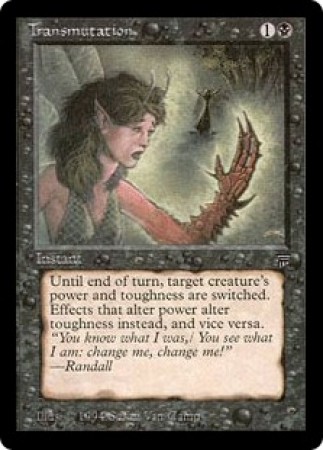
Spells that give the recipient
enhanced
Strength or the ability
to fly, those that transform
substances (polymorph
self or others)
and spells that have general
effects (move
earth or lower water) are
all alterations. This
magic is the province of
the Order of the Red
Robes alone.
Conjuration/Summoning
spells are a combination
of two separate magics in
variable
quantities: The conjuration
part brings additional
matter from elsewhere, while
the summoning
portion creates a duct between
the
caster and some greater
magical power.
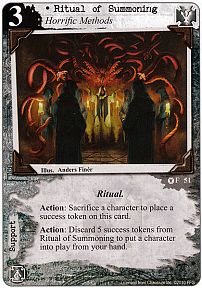
Spells
that summon existing animals
or monsters in
an area, bring into being
on this plane extradimensional
creatures (such as elementals,
for
example), or use such creatures'
power (such
as a wish or power word)
are conjuration and
summoning magics. Both conjuration
and
summoning are usable by
the Order of the
Red Robes. Conjuring may
be used by the
White Robes as well, while
summoning may
be used by the Black Robes.
Divination
spells are those that uncover
information that is otherwise
hidden under
normal circumstances and
include spells that
detect magical effects,
invisibility, and the
like, those spells that
predict hidden or future
events, and those that place
the caster in contact
with powerful extradimensional
creatures
but do not involve direct
action by those creatures.
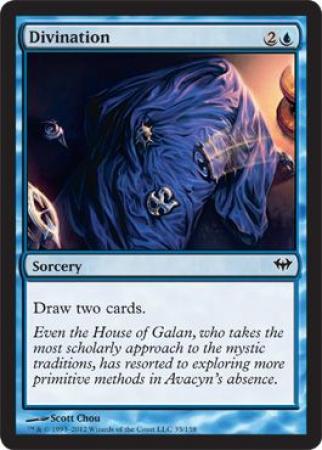
This sphere is the common
ground of all
Krynn magic and all wizards
can use divination
spells regardless of their
order.
Enchantment/charm
spells place a
dweomer on the target individual
or item that
radiates a magical aura.
On physical items it is
normally used to invest
an item with magical
powers (such as deeppockets
or bind), but is
more commonly used to induce
particular
emotional or mental states
in living targets
(such as animal friendship,
forget, and Otto's
irresistable dance). The
magic jar spell, which
was originally listed as
a possession spell, is
really an enchantment/charm
spell. These
spells can be used by wizards
of the White and
Black Robes.
Evocation
and invocations both channel
magical energy, using that
energy to create
specific effects and types
of matter.
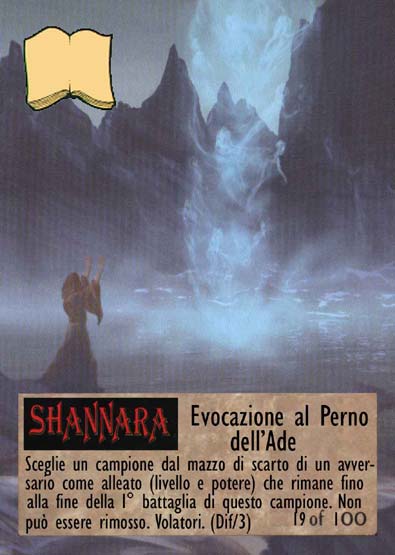
These effects include permanent
features such as the
wall spells, forces
such as the Bigby's hand
family of spells, and temporary
effects such as
lighming bolt or fireball.
Invocations are dedicated
to a particular powerful
extradimensional
being and are usually confined
to
clerics, while evocations
involve utilizing
ambient magical energy.
These spheres of
magic can be used by the
Orders of the Red
Robes and the White Robes.
Illusion/phantasm spells create a false reality.
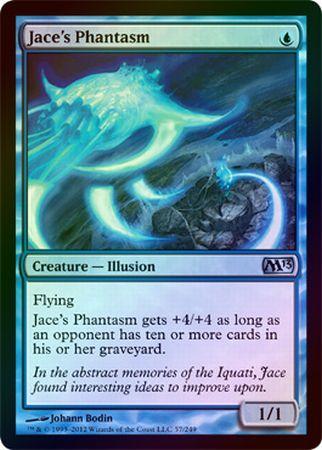
This sphere includes the
bulk of the spells
listed in the illusionist
sub-class. Illusions
alone create the apparent
existence of items in
the minds of the viewers,
while phantasms
create a shadow reality
that gives these illusions
the power to affect the
viewer as if real.
These are the province of
the Red Robes and
the Black Robes.
Necromantic
spells involve the health,
HPs,
or
normal functioning of a
living || once-living TARGET.
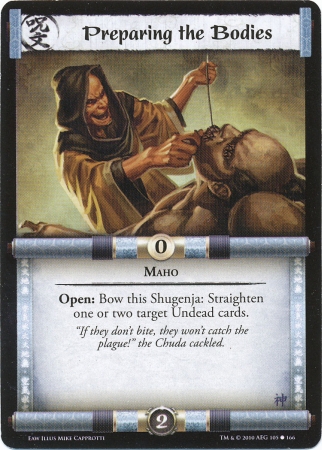
Spells that increase or
decrease HPs,
cause or cure disease, or
restore lost souls to their
bodies all are necromantic
spells. These are the province
of the
Black
Robes.
A summary
of magical spells divided:
according
to level and spell type can be found
on
pages 126 and 127. Use this list m determine
which
spells are usable by the different
orders
of wizardry.
Originally there were five
Towers of High
Sorcery. Built by the ancient
wizards as centers
for their crafts and learning,
they were located
in the ancient cities that
later came to he
called Palanthus, Wayreth,
Istar, Daltigoth,
and the Ruins.
Q: Exactly how many
Towers of High
Sorcery were there originally,
and
where were they?
A: There were once
five towers. Their
locations were: Palanthus,
Wayreth, Istar,
Daltigoth, and the Ruins
(DLA, page 29).
(143.98)
The towers were all alike
and yet all different.
The general outline of the
towers was
determined by a central
committee of members
of all three orders (since
all orders use the
towers), but the supervision
of the construction
work was done by wizards
who happened
to live in the area. This
resulted in the same
general structure for all
towers, but widely
varying details and specific
layouts.
The general arrangement
of the towers con-
sisted of a central complex
surrounded by a
field or garden. This field
was different for
each of the five towers.
The Tower at Wayreth
was surrounded by a transdimensional
field
that allowed it to appear
anywhere within 500
miles of its usual place
in Wayreth Forest. The
Tower in Palanthus was surrounded
by the
Shoikan Grove that emanated
a continuous
and very powerful fear spell.
These are the two
towers that are most commonly
known today.
Knowledge of the other three
towers is hard to
come by, hut the properties
historically
ascribed to these towers'
gardens were sleep
(Daltigoth), forget (Istar),
and passion (the
Ruins). While each of these
gardens held
9m any other formidable
obstacles, these were
their principal attributes
and defenses.
All towers are neutral zones.
Fighting
among the wizards is not
permitted and is
punishable by immediate
death.
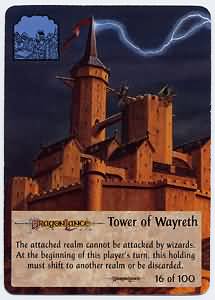
The Wayreth
Tower's defense is the most
unusual, for one does not
seek out the tower,
it finds you. The garden
about Wayreth's Tower
has different dimensions
at different times
and the Tower itself is
said to exist without
dimension, always existing
where it is not.
The result is that one could
be walking in a
forest and suddenly be trespassing
within the
domains of the wizards of
Wayreth. Just where
this tower's garden touches
the world of men
and elves is controlled
by the wizards themselves.
In this way they protect
the tower from
enemies of their order while
still enabling wizards
to enter the tower.
Access
to the Wayreth Tower is the most
restricted of all the Towers
since the Masters of
High Sorcery decide who
may enter. The tower
is never where it is looked
for and can only
be found when the wizards
wish it to be so. It
is impossible for a character
to enter the tower
though astral travel or
the outer planes of
existence as the tower is
not connected to
those planes. (Only the
Tower Portals can
touch on the other planes;
otherwise, Raistlin
would have had little difficulty
in reaching
the domain of the Queen
of Darkness).
If the
wizards want a person to enter the
Wayreth Forest, he has little
choice in the matter.
He may wake to find himself
surrounded
by trees. He may try to
walk away, only to find
himself inexplicably walking
into it. Or he
may be lured inside by the
magical singing of
birds promising him his
heart's desires. Anyone
attempting to enter the
forest without
invitation can do so, but
he better be prepared
to give a good explanation
of himself to the
wizards quickly. Otherwise
he is attacked by
the trees.
Even those
invited into the forest (such as
mages traveling to take
the Test) are accosted
by the feeling of overwhelming
magic. It takes
every bit of courage and
will they possess to
make their way to the tower
itself. Wizards
generally travel to the
tower via magical
means and do not bother
to go through the
forest. The exception to
this would be a renegade
wizard, who would not be
permitted to
teleport or otherwise enter
the tower without
permission.
The Tower
of Wayreth differs from the other
towers in that it contains
a great central hall
where the Conclave meets.
This hall is huge,
so large that the ceiling
is lost in shadows. It is
round, made of stone, and
there are no decorations
or enhancements of any kind.
Stone
chairs, created by magic,
stand in a semi-circle
at one side of the hall.
There is light without a
source in the hall; it is
brightest upon the
semi-circle of chairs. The
entrances to this hall
are magical. No one is permitted
inside unless
the wizards transport him
here. Anyone wandering
about the tower would never
encounter
the hall.
The black,
rune-covered walls of the Tower
of Wayreth were built by
magic and are part of
the tower's defenses. No
weapon exists that
can even mar the surface
of these walls. Thus
the Tower of Wayreth remained
standing relatively
untouched when the rest
of the world
was destroyed in Raistlin's
attempt to overthrow
the gods. There are no guards
at the
gate of the tower; there
is no need. Once
inside the gates, the adventurer
passes
through a huge courtyard
paved with gray
flagstone. The courtyard
appears empty at
first glance, but anyone
walking across will
suddenly realize that it
is filled with people!
They cannot be seen directly,
only out of the
corner of the eye. These
are mages traveling to
and from the tower, mages
taking the Test,
mages experimenting, etc.
An adventurer
in the courtyard--if invited
to the tower--is transported
magically to one
of the tower's many sumptuous
guest rooms.
These are like the most
luxurious rooms of the
best inns in Krynn. Uninvited
guests (those
who make it this far!) are
either taken immediately
to stand before the Conclave
or to the
dungeons. The dungeons of
the towers are so
dreadful that no report
of them has reached
the outside world--no one
who ever went in
came back alive to report
on it.
A wizard
entering the tower receives his
own private quarters, the
placement and
decor of which depend on
the wizard's level.
Student magic-users and
apprentice wizards
have their rooms on the
same level as the guest
chambers. High-level mages
have more elegant
quarters at the top of the
tower. There are
no locks on any doors as
all wizards respect the
sanctity of others' possessions.
There
are libraries of spell books within the
tower, plus libraries of
magical scrolls and
magical paraphernalia. These
are under the
control of the Conclave
and can be given as
gifts to magic-users (almost
all young wizards
who pass the Test are given
some powerful
artifact to aid them in
their profession). These
may also be purchased (in
the case of artifacts
and scrolls) or studied
(in the case of spell
books) with the permission
of the Conclave.
Purchase
prices for items would most likely
be in terms of similar items
rather than
money. A wizard desiring
to purchase a scroll
would offer another scroll
in exchange or some
other magical object of
comparable value.
Thus a White Robe wizard
who comes across a
scroll of evil magic would
not destroy it, but
rather take it to the tower
to trade for a scroll
he can use.
Wizards
can choose to be buried within the
tombs of the tower, although
this is not mandatory.
It is rumored that those
who choose to
rest within the tower's
walls serve their art
even after their death by
performing such
tasks as guarding the dungeons
or aiding in
the Testing of young wizards.
At the time of a
wizard's death, all possessions
and spell books
are either bequeathed to
an apprentice, a fellow
wizard, or sent to the tower.
Thus there
are no magical artifacts
buried in the tombs of
the tower.
Adventuring in the tower can be fascinating
because
the DM is relatively free to do with it
as
he chooses. See the map of the tower (page
32)
for detailed information.
The Shoikan Grove of the Tower of Palanthus
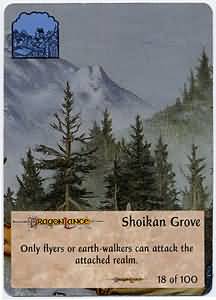
The fear
generated by the Palanthus Tower
is one of the most respected
visible defenses of
the five. This permanent
spell is of such power
that only one uninvited
guest has ever reached
the tower--Tasslehoff Burrfoot
managed to
penetrate the Shoikan Grove
while piloting a
flying citadel over Palanthus.
Wizards are
generally of the opinion
that the penetration
was due to the fact that
the citadel was a
device of magic itself and
the pilot of the citadel
was, at the time of the
penetration,
encased in a magical field.
In the
time following Raistlin's death,
Dalamar, the successor to
Raistlin as the Master
of that Tower, laid further
enchantments
on the garden to extend
its effects and powers
into a dome that encased
the tower as well as
shielding it physically
from any assault. Projectiles
now deflect harmlessly (as
would flying
citadels) and the fear that
emanates from
the grove is unchallengeable.
Passage through the Shoikan Grove without
a
talisman requires a saving throw vs. spell
with
a - 10 penalty, to the die roll (a difficult
roll
at best). A character failing this check
(which
must be made every five rounds the
character
remains in the grove) succumbs to
irrational
fear and blind panic, fleeing the
grove
in the direction from which he came.
The
talismans that are given out for passage
through
the grove negate the penalty, but the
character
must still successfully make the saving
throw
or flee in uncontrolled panic: (See
page
98 for the talismans that enable safe passage
through
Shoikan Grove.)
The Tower of High Sorcery at Palanthus
The Tower
of High Sorcery at Palanthus
changes in aspect depending
on when in its
history it is visited.
Pre-Curse
Originally
one of the most beautiful of the
towers, the Tower at Palanthus
was also
considered one of the most
powerful. Here it was
that the wizards
of all the orders came together
to create the dragon
orbs that were responsible
for helping to defeat the
Dark Queen.
Any entering
the tower at this time would
find it similar to the description
of the Tower
of Wayreth, except that
this tower is equipped
with a laboratory instead
of a great hall. (See
the description of the laboratory.)
The Curse
During
the Age of Might, the wizards grew
so powerful that many people
feared they
might take over the world.
Among these was
the Kingpriest of Istar,
the powerful cleric of
good. He turned the people
against the wizards.
Mobs rose up and attacked
the towers.
It would
have been easy for the wizards to
have destroyed the people,
but they knew that
in so doing they would destroy
the world.
Rather than doing this,
they chose to sacrifice
their own power in the world.
They destroyed
two of the Towers of High
Sorcery--those at
Daltigoth and the Ruins.
They turned the
Tower at Istar over to the
Kingpriest and were
intending to give him the
Tower at Palanthus
but for the terrible event
that was to befall it.
In return, they were allowed
to retain the Tower
at Wayreth, and it was here
that they
brought as much of their
libraries and as many
of their magical artifacts
as was possible.
At the
beginning of the ceremony to TURN
over the Tower of Palanthus
to the Kingpriest's
representative, an evil
wizard--driven insane
by the downfall of his art--leaped
from an
upper window and impaled
himself upon the
spikes of the tower's gate.
As his blood flowed
to the ground, he CAST a
curse upon the tower,
saying that no living being
would inhabit it
until the Master of Past
and Present returned
with power.
It is
unlikely that any would be able to enter
the Tower during the period
the curse is in
effect. The only ones known
to have done so
were Raistlin, Caramon,
and Crysania, who
came here long after the
Cataclysm (Raistlin
mistakenly believed a Portal
existed in the
tower at this time).
The tower
is guarded by undead of all sorts
that permit an adventuring
party in the tower
only if Raistlin (whom they
would recognize)
is present.
The Tower During Raistlin's Rule
Those
who enter the tower during this time
are undoubtedly here by
invitation and are, in
any case, completely under
Raistlin's control.
They therefore see only
what Raistlin wants
them to see. This might
include Raistlin's
study, a luxuriously appointed
room filled
with books, comfortable
furniture, and
objects of interest from
all over Krynn. A fire
in the hearth dispells the
chill of the tower.
The books
in this room are not spell books;
those are in the laboratory.
These books are
works of poetry and prose,
books on herbal
lore and anatomy, books
on philosophy, and
treatises on magic. The
objects decorating the
room are also nonmagical,
being beautiful or
hideous but all curious.
These are memories
Raistlin acquired in his
travels.
Dalamar's Quarters
Dalamar
is Raistlin's only apprentice.
Despite the fact that he
is a dark elf, his quarters
are very elven in design,
being decorated
with rugs and furniture
that celebrate the
beauty of nature. There
are also many interesting
and curious objects in these
rooms, plus
many magical ones and Dalamar's
spell
books.
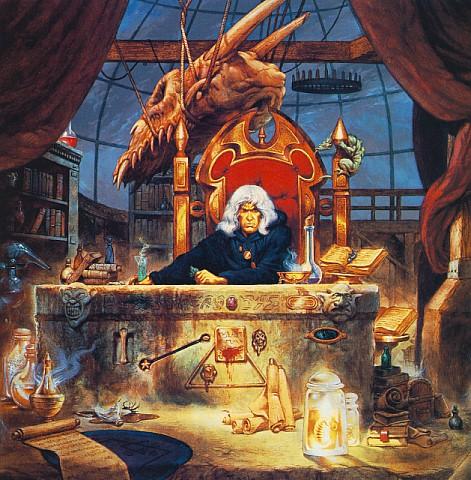
The laboratory
is located in the top of the
Tower and can be reached
only after climbing
a narrow stone stairway
that spirals up the
inner wall of the tower.
SInce the center of this
part of the tower is hollow,
one misstep on
those stairs means that
the person falls to his
death.
Upon entering
the laboratory, adventurers
note that it is much larger
than it could possibly
be, given the size of the
tower. The primary
object in the room is the
great stone
table. Dragged from the
bottom of the sea by
magic, it is so large that
a minotaur can lay
down full length upon it.
It is covered with
runes to ward off any outside
influences that
might affect the mage's
work.
Also present
in this room are shelves of spell
books. These incl. the night-blue
bound
spell books of Fistandantilus,
plus Raistlin's
own black-bound
spell books. Here also are
books on herbal lore and
anatomy, many of
them in Raistlin's own handwriting.
Various
magical items and artifacts
are also here.
Raistlin
is an expert in alchemy, so bottles
and beakers of various chemicals
are found
both on the stone table
and in other parts of
the laboratory. He has also
delved into the
art of vivisection, and
various animals and parts
of animals (incl. humans)
can be seen in
jars and beakers. Several
complete skeletons of
animals and humans stand
in the corners.
Parts of skeletal remains
lie about. Some of
Raistlin's experimental
creations live in jars or
cages and take an avid interest
in any newcomer
who enters the lab.
At the
far end, almost obscured by
shadows, hangs the
purple velvet curtain that
hides the Portal. If these
curtains are drawn,
the character sees an oval
doorway standing on
a
golden dais. It is surrounded by the dragon
heads of Takhisis, the Queen
of Darkness.
When not activated, these
heads appear to be
plain
gold metal, although the character may
have the uncanny feeling
that the eyes of the
heads are watching his every
MOVE. When
activated, the heads glow
blue,
red,
black,
green
and white and scream the praises of
their Dark Queen.
Characters looking into the Portal when it is
not
activated see only a dark void. Those looking
into
it when it is activated see a swirl of
brilliant,
blinding color, then whatever the
DM
wants them to see.
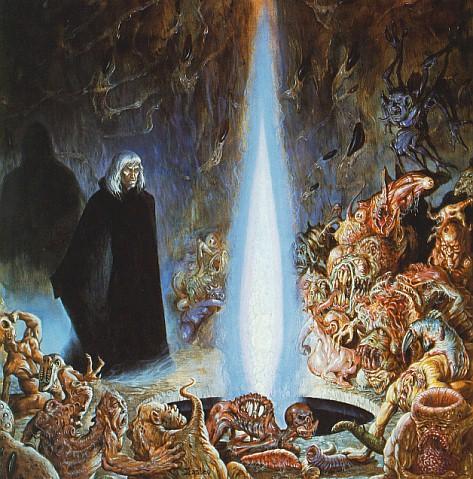
Here dwell
the Live Ones, Raistlin's failed
experiments in creating
life. He is unwilling
to show them to anyone with
the exception of
Dalamar. Their task is to
watch the pool that is
Raistlin's window on the
world. Looking into
it, he can see anything
that is currently happening
anywhere in Krynn and can,
to a certain
degree, affect the actions
of those he sees.
He can only VIEW the present
in the pool, he
cannot see either the future
or the past.
The pool
is quite similar in nature to the
crystal he (as Fistandantilus)
presented to
Astinus the Historian.
The Live Ones are quite harmless, but so
gruesome
looking and foul smelling that any
character
not of evil alignment must successfully
roll
a Constitution Check or become violently
ill.
This has the effect of lowering the
character's
attack roll by -3 and penalizing
his
AC by +3 while he is in the Chamber of
Seeing.
When Dalamar
became Master of the Tower,
he instituted many changes.
Among these
are opening up living quarters
for additional
apprentices. His most important
act, however,
was to shut the laboratory
and seal it with a
powerful curse. A lich guards
the door and
suffers none to pass.


Guardian Groves of the Destroyed Towers
The following are suggestions
for those
wishing to set a campaign
in pre-Cataclysm
Krynn before the other three
Towers of High
Sorcery were destroyed.
The towers are similar in
construction to
those in Palanthas and Wayreth
with the
exceptions noted on page
29. Each tower's
guardian grove had different
characteristics.
Daltigoth (sleep):
All living beings entering
this forest must make a
successful saving
throw vs. spell with a -
7 penalty every five
rounds they are in the forest.
Those who fail
fall into an enchanted sleep.
The sleeping
being is then transported
by the wizards either
into their tower or out
of the forest, depending
on whether or not they wish
to have dealings
with him.
Istar (forget): Those
entering this forest must
roll a successful saving
throw vs. spell with a - 5
penalty every five rounds
they are in the forest.
Failure temporarily negates
all short-term memory,
thus making k Impossible
for a person to
remember from moment to
moment what it is
9th ey are doing here. This
effect passes once the
characters leave the forest.
Ruins (passion):
The character finds his
own passions overwhelming
him. These may
be of love, hate, vengeance,
etc. A saving
throw vs. spell must be
successfully rolled every
five rounds to avoid this
effect.
The Test of High Sorcery
is more than just a
trial of a person's magical
abilities, it also tests
how that person will use
the abilities he has
and those he will gain.
Magic is powerful in
the world of Krynn and,
to the wizards, the
distinctions between the
three different factions
of wizardry are most important.
Each initiate's test is a
different one,
designed especially for
his needs and weaknesses.
Failure means death. Because
magic is
such a powerful force in
the world, the wizards
are extremely careful about
who is allowed to
wield this power. They are
not interested in
whether the power is used
for good or for evil
so much as they are concerned
with irresponsible
use of the power (one reason
there are no
kender magic-users!). A
wizard who agrees to
take the Test, therefore,
literally pledges his
life to the magic. He must
prove to the satisfaction
of his fellow wizards that
he takes
magic seriously and that
he will devote his life
to magic.
As
each Test of High Sorcery is designed foal
the
individual, there is no specific Test
detailed
here only guidelines as to how such
a
Test must be conducted and what the Test
should
include. It is up to you to design the
details
of the specific Test for the wizards in
your
campaign.
There
should be at least three tests of the
wizard's
knowledge of magic and its use; the
Test
should require the casting of all of the
spells
known to the initiate; at least three tests
that
cannot be solved by magic alone; at least
one
combat against a character known to the
initiate
as an ally; at least one solo combat
against
an opponent who is two levels higher
than
the initiate.
Those
attempting the Test can bring com-~i
panions
along, but no one who comes is guaranteed
of
returning alive.
One
such Test offered by Dalamar allowed i
the
initiate and his parry to enter the tower
freely--getting
out, however, was another
matter.
Changing Orders After the Test
From time to time, a wizard's
actions will
indicate that he is no longer
a follower of the
tenets of his originally
chosen order. Raisdin
Majere, for example, won
his Red Robes in his
Test but thereafter events
and his own decisions
brought him to the way of
the Black Robes. Such
changes are not without
hardship.
A wizard
who changes orders suffers the los,,
of
two experience levels. This may make the~
wizard's
spell book unusable in some
instances
(since the types of spells a wizard
receives
depend on his order, the spells in his:
old
book may no longer be usable when he;
changes
orders).
Also,
the wizard's abilities are not affected
by
any moons until one game month has
passed
after his change (then the moon of his
new
order affects his abilities).
Q: Wizards who change
orders lose
two levels of experience.
If a wizard
of 4th level or less opts
to change
orders, he will become a
student
wizard. In such cases, does
the wizard
have to undergo a new Test
of
High Sorcery, or is he automatically
accepted by his new order?
What
about wizards who are reduced
below 3rd level by energy-draining
undead?
A: Since Tests of
High Sorcery are grueling,
life-threatening affairs,
it is reasonable to
assume that no wizard who
has proved
himself once will be asked
to undergo a
new test, the matter in
which he lost his
experience level not withstanding.
(143.12)
Q: In the spell summary
on pages 126
and 127 of DLA, spells are
listed by
sphere. Some spheres are
listed as
combinations, such as Conjuration/
Summoning. Does a wizard
have to
be able to use spells from
both
spheres in order to cast
spells from
such a combination sphere?
A: No. A wizard can
cast the spell as long as
at least one of the spheres
is open to him.
However, some spells are
limited to one
sphere of the combination.
For example,
the armor spell is strictly
a conjuration;
only a wizard who has the
conjuration
sphere open to him can cast
an armor
spell.
(143.98)
Wizards who attempt to live outside the
law of the Towers of Sorcery are known as renegade
wizards. Wizards from other campaigns
who do not quickly contact the heads of an
order they wish to join will find themselves in
the position of being considered a renegade
wizard.
Renegade wizards are considered by all
orders to be a menace to the balance of magic
in the world. It was only by the barest of margins
that Raistlin, a magic-user of extraordinary
powers, retained his station in the Order
of Black Robes since he was obviously intent
upon defying them by entering the Abyss and
challenging the gods. Why the Conclave did
not order his destruction is unknown. (Most
believe that it was because they feared they
would not be able to stop him.) Thus they
sent the dark elf apprentice wizard, Dalamar,
to spy on him and eventually attempt
to
destroy him.
A renegade wizard who has come to the
attention of the orders is invariably seen as a
threat that must be either neutralized or eliminated.
Each of the orders has its own way of
dealing with a renegade some orders are
more benevolent than others, but all are
equally effective in their methods.
Wizards who enter Krynn from other cam,
paigns are considered renegade wizards until
such time as they declare their alignment to
an
order.
Such wizards use the standard wizard tables
found in the DMG and the PH. <(Spells
at 1st Level, Recovery of Spells), (Intelligence
Table II: Ability for Magic-Users, Magic-Users
Table I)>
It should be explained to the player,
however, that the standard tables are far less
favorable for a wizard than those for the orders
of Krynn.
A character who starts in Krynn can opt to
become a renegade after he reaches 3d level.
Alternatively, a character can leave an order
after having joined and become a renegade by
not joining another order, Note that any wizard
character leaving the Orders of High Sorcery
is subject to the two-level loss penalty
required of anyone who leaves an order. At
that point he begins to use the magic-user
tables in the PH.
His experience point total is altered so that
he has only 1
point more than is necessary to reach his current
level (after the two-level drop).
Players who run their characters as renegades
from the beginning also use the
AD&D game system
charts for magic-users, <(Spells at 1st
Level, Recovery of Spells), (Intelligence
Table II: Ability for Magic-Users, Magic-Users
Table I)>
but they are not subject to any level penalties.
An additional problem with being a renegade
wizard is that there is a 50% chance that any
other wizard encountered will recognize a renegade
wizard. This chance is decreased by
20% if the renegade is disguised as a wizard
from an order other than that of the identifying
wizard.
Renegade wizards who are recognized by a
wizard of another order are dealt with in ways
that depend on the order of the wizard. A wizard
of the White Robes will try to capture the
renegade by any means at his disposal while
doing the least harm. Should he fail, he will
report the renegade to the nearest tower,
keeping close watch on him meanwhile. He
would destroy the renegade only as a last
resort and then only if the renegade threatened
either the balance of magic or the lives of
others.
A wizard of the Red Robes will try to capture
the renegade and bring him before the
Conclave, if possible. If this is not possible,
he
would not hesitate to destroy the renegade.
A Black Robe wizard will at first attempt to
win the wizard over to his side of the struggle
before destroying him.
Renegade wizards who are brought before
the Conclave are given a chance to join one of
the Orders of High Sorcery and to abide by its
laws. Those who refuse are cast out from the
realms of Krynn and the circles of the world.
Those who join the Orders of High Sorcery ate
entitled to use the better advancement tables
and all of the benefits of the towers.
If, from time to
time,
a character comes
across something that is too hard for him to
believe (even in Krynn!), then the character
may have cause to question whether the thing
is real or merely the strange concoction of
some illusionist
wizard.
Disbelieving an illusion requires a period of
concentration. If a character wants to disbelieve
an illusion, follow these steps:
1) Ask the player how long his character will
concentrate on the suspected illusion. This
should be given as a number of melee rounds.
2) Determine the modifier for the disbelief
check. Compare the duration of concentration
time to the following table to determine a
concentration modifier for the roll.
Concentration Modifiers for Illusion Disbelief
| Time | Modifier |
| 1 Round | +1 |
| 2 Rounds | +2 |
| 3 Rounds | +3 |
| 4-6 Rounds | +4 |
| 7-9 Rounds | +5 |
| 1-3 Turns | +6 |
| 4-6 Turns | +7 |
| 1+ Hours | +8 |
During this period of concentration, the
character can perform no other actions. It is
the uninterrupted period of concentration
that determines the modifier. Note that the
available concentration time of any character
will be very limited if the illusion attacks
the
character.
A character who has taken damage from an
illusion does not get a chance to disbelieve
it.
3) Determine the Disbelief Number by
adding the concentration modifier to the
character's Intelligence. You may also add 1
for each other character who has successfully
disbelieved during any previous round.
4) The referee secretly rolls 1d20. If the
result is higher than the Disbelief Number,
then the object in question looks real and its
effects are as if it is real. If the number is
equal
to or lower, then the illusion is disbelieved.
A disbelief check can be made only once per
hour by a character against any one illusion
(but the character can check again whenever
another character in the group makes a successful
check). The illusion is either discovered
by the character or else is believed. If an illusion
is a group of monsters, then the check is
made for the entire group, not to disbelieve
each individual monster. A successful disbelief
of a group of monsters would tell which
were real and which were not should illusions
be interspersed with real ones. Characters who
successfully disbelieve cannot be harmed by
illusions.